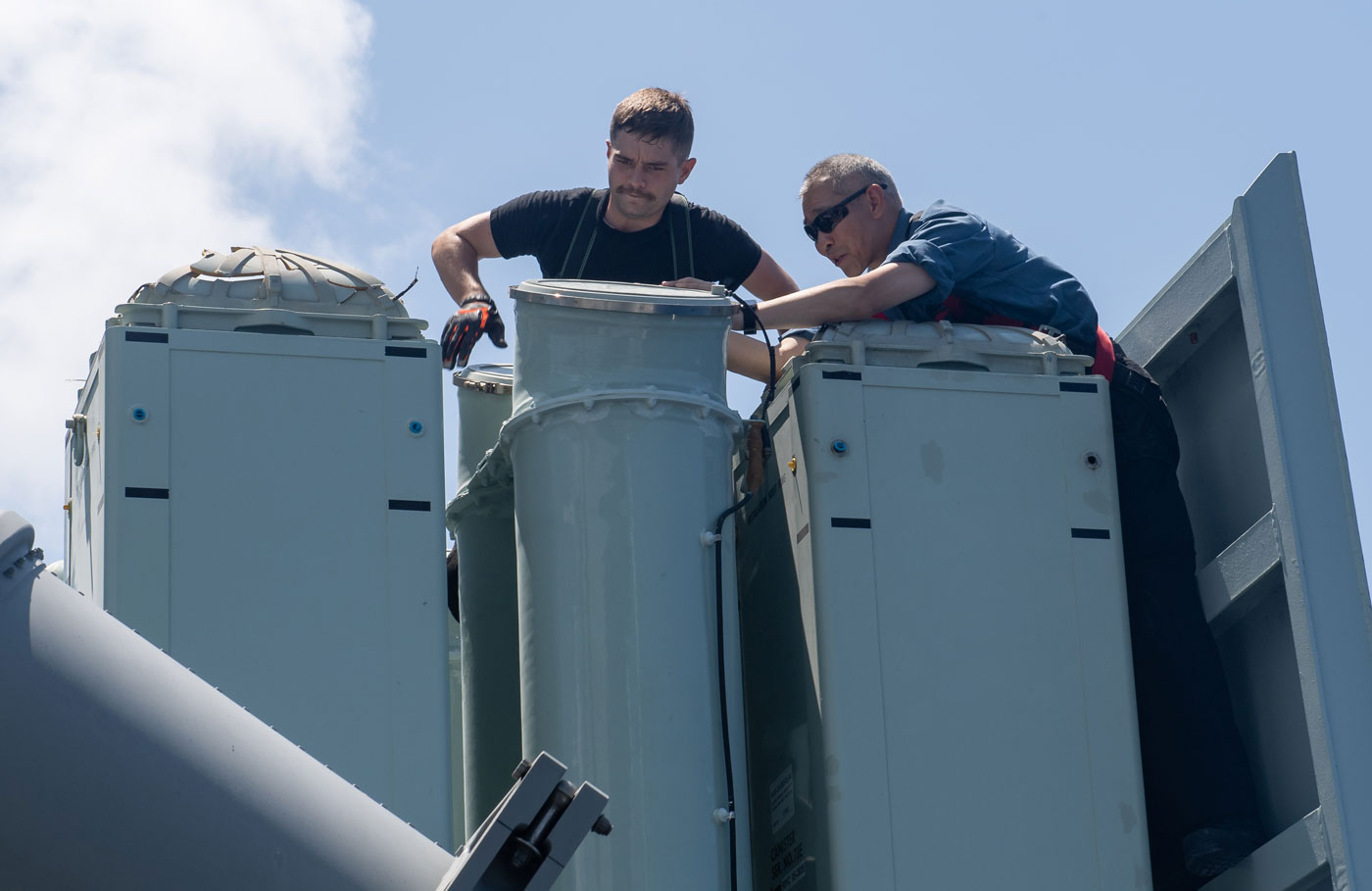Making HMCS Winnipeg “Weapons Ready” – The challenges during a pandemic
By Lookout on Sep 11, 2020 with Comments 0

Members of HMCS Winnipeg conduct post-firing maintenance on the Evolved Sea Sparrow Missile (ESSM) launcher off the coast of the Hawaiian Islands. Photos by Leading Seaman Valerie LeClair, MARPAC Imaging
Captain Chelsea Dubeau, HMCS Winnipeg Public Affairs Officer ~
It’s Monday, Aug. 24; day eight of Exercise Rim of the Pacific (RIMPAC) 2020.
The air throughout the ship is tense – anticipatory.
The planning for the Evolved Sea Sparrow Missile (ESSM) shoot has been in the can for a long time, the sequence of events practiced over and over.
War bags filled with flash gear are clipped to belt loops, and the ship’s company waits for the Bong Bongs to don gloves, head covering, and ballistic eyewear required for the event. All that planning, all that preparation, all those meetings and changes and coordination and de-conflicting, all comes down to one moment: one flash, one missile moving at unimaginable speed. Except on this day, two missiles will be fired down range.
The GoPros have been placed strategically to best capture the footage. This is the second attempt to fire in as many days. The first try was close, but didn’t kick off due to an issue with the aerial target’s flight path in relation to the ship’s position the day prior. It’s now or never.
The ship comes to action stations in preparation for the shoot as the target moves closer to the ship, the threat as real to the crew as everything else they’ve been training for during Intermediate Multi-Ship Readiness Training (IMSRT). The target is engaged, and weapons launched.
Two missiles are fired, one after another, as speechless sailors viewing on the bridge take in the sight of two ESSMs arc across and against a deep blue sky. It’s a win shared by the entire ship’s company, and it feels good, especially considering how many challenges were stacked against the ship.
Preparing to deploy is difficult under normal circumstances, but in the COVID-19 environment, it’s never been done before.
“COVID-19 and the sequestering restrictions put in place on the ship’s crew was a challenge,” says Lieutenant (Navy) Julien St-Aubin, Combat Systems Engineering Officer, referring to the lead up to the Aug. 1 departure. “The ship’s leadership worked endlessly from home to discuss, plan, and brief the various challenges and mitigations that arose while still being required to meet RCN processes and policy both on the technical and operational sides.”
One area where the technical and operational sides meet is in the various weapons systems on board, all of which play a critical role in both programs running concurrently on board Winnipeg: IMSRT, and of course, RIMPAC. Much of these systems are refurbished or new, and there are many challenges that go along with working out the kinks of new equipment on top of everything else the ship faced in order to get ready for sea.
“Newer weapons systems can be finicky as the parts need to work themselves in, allowing the mechanical parts to work seamlessly as intended. This caused a few issues, but they were identified and corrected early in the deployment,” says Lt(N) St-Aubin.
The new system on board is the Naval Remote Weapons System (NRWS), which can fire both .50 calibre and 7.62mm rounds remotely, eliminating the need to put a sailor outside at the mounts if the ship comes under attack.
While new weapons bring new capabilities, they also provide a new learning curve especially when it comes to troubleshooting. In addition to this new capability, a new 57mm MK III Bofor gun was installed, maintenance was completed on Winnipeg’s Close-in Weapons System (CIWS), and inspections of the missile superstructure were conducted to check for any degradation. Whether conducting training, an international exercise, or operations – or in Winnipeg’s case, all three – there is simply no room for error. When those weapons systems are needed, they have to fire.
“From a technical Combat Systems Engineering perspective, the Weapons Engineering Technicians are truly put to the test as all systems are depended upon with a very short turn around as faults come up,” says Lt(N) St-Aubin. “The ability to correlate faults and troubleshoot very complex systems integrated within the ship’s weapons and sensors architecture can be the ultimate puzzle to solve.”
In spite of all of these challenges – deployment planning in a COVID-19 environment, new weapons systems, a complex IMSRT program layered on top of RIMPAC, followed by an international deployment during a pandemic –Winnipeg continues to persevere, charging into every hurdle like the iconic bison painted on its Bofor gun.
Outside-the-box thinking is necessary for dealing with new, adverse situations in order to come up with creative solutions. And it’s paying off for Winnipeg, even if it has been a difficult climb up the mountain. The successful missile shoot is just the tip of the iceberg, after all, because for all the flashy photography and GoPro footage captured that day, the real reason it was so exciting to see that missile shoot across the sky wasn’t just because it’s an amazing weapon system.
It’s because of the sheer hard work and effort it took to get there.
––––
Filed Under: Top Stories
About the Author:





